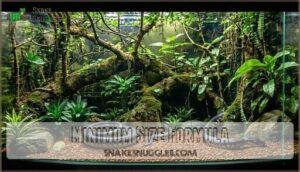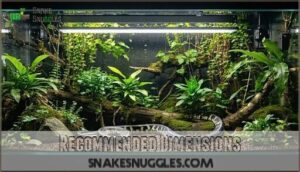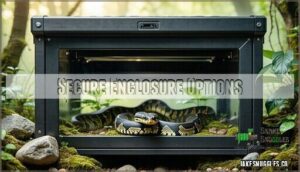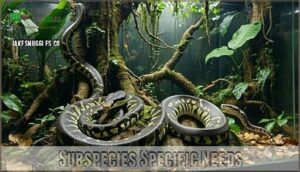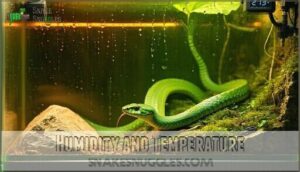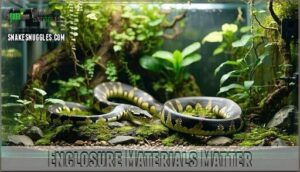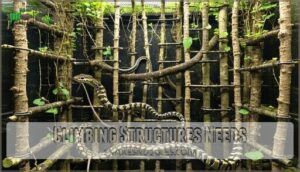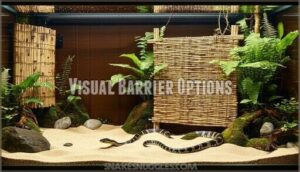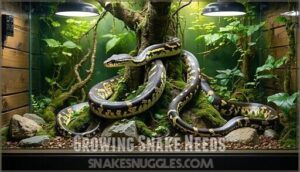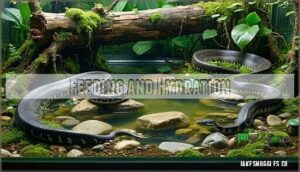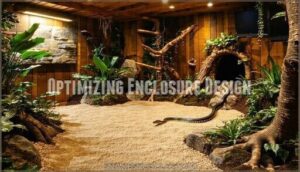This site is supported by our readers. We may earn a commission, at no cost to you, if you purchase through links.
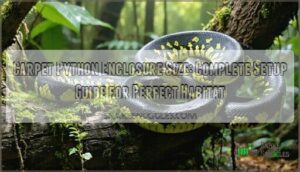 Your adult carpet python needs a minimum carpet python enclosure size of 4 feet long by 2 feet wide, though bigger is always better.
Your adult carpet python needs a minimum carpet python enclosure size of 4 feet long by 2 feet wide, though bigger is always better.
Most keepers use the "snake length times half snake length" formula – so an 8-foot python gets a 4×8-foot enclosure minimum.
Adult carpets thrive in 4’x2’x2′ setups, but coastal subspecies often need larger spaces due to their impressive size.
These semi-arboreal climbers also require vertical space for natural behaviors.
Don’t forget that juveniles can start smaller but will need upgrades as they grow – and there’s more to account for than just floor space when creating the perfect python paradise.
Table Of Contents
- Key Takeaways
- Carpet Python Size Needs
- Enclosure Size Requirements
- Subspecies Specific Needs
- Humidity and Temperature
- Enclosure Materials Matter
- Vertical Space Importance
- Growing Snake Needs
- Feeding and Hydration
- Maintenance and Cleaning
- Optimizing Enclosure Design
- Frequently Asked Questions (FAQs)
- How big do carpet pythons get?
- What size enclosure do carpet pythons need?
- How big should a carpet python tank be?
- How big should a carpet python vivarium be?
- How big should a Python enclosure be?
- Do carpet pythons need a front entry enclosure?
- What size tank do you need for a carpet python?
- Is a carpet python a good beginner snake?
- Can carpet pythons be kept together?
- Do carpet pythons need high humidity?
- Conclusion
Key Takeaways
- You’ll need a minimum 4′ x 2′ x 2′ enclosure for most adult carpet pythons, but larger subspecies like Coastals require up to 8′ x 4′ x 4′ spaces for proper movement and natural behaviors.
- Don’t buy based on your snake’s current size – plan for their adult dimensions since carpet pythons can reach 6-10 feet, with some stretching up to 10.5 feet depending on subspecies and genetics.
- You’ll want at least 3-4 feet of vertical space since these semi-arboreal climbers need sturdy branches and elevated perches to express their natural climbing behaviors and reduce stress.
- You’ll need to upgrade your python’s enclosure as it grows – juveniles typically need their first size increase around 12-18 months when they’ve doubled in length from their hatchling size.
Carpet Python Size Needs
Understanding your carpet python’s size potential is essential for creating the right habitat from day one.
These semi-arboreal snakes typically reach 6-10 feet in captivity, with the maximum recorded length hitting 10.5 feet.
Planning the right enclosure from day one matters—these impressive pythons can stretch up to 10.5 feet!
You’ll need to plan your enclosure setup based on their adult dimensions rather than their adorable hatchling size, to ensure a suitable environment for your pet.
Average Length Requirements
When planning your carpet python enclosure size, you’ll need to take into account their impressive length potential.
Most carpet pythons reach 6-8 feet, with females often growing larger than males across subspecies.
Key Length Calculations for your setup:
- Males typically max out at 6-8 feet requiring different space needs
- Females can stretch 8-13 feet demanding more generous enclosure dimensions
- Growth rates vary substantially between subspecies and individual genetics
Understanding these size guidelines helps you plan appropriate snake tank dimensions from the start, avoiding costly upgrades as your python matures.
Maximum Recorded Length
When considering carpet python habitat requirements, you’ll find that the maximum recorded length reaches approximately 3.2 meters (10.5 feet).
These record breakers establish key size limits for planning your python enclosure size and snake tank dimensions.
| Subspecies Category | Typical Maximum | Record Lengths | Enclosure Impact |
|---|---|---|---|
| Smaller Types | 5-7 feet | 8 feet | 6’×3′ minimum |
| Medium Types | 7-9 feet | 10 feet | 8’×4′ recommended |
| Coastal Giants | 9-10 feet | 10.5 feet | 10’×4′ or larger |
| Growth Patterns | 5 years peak | Varies by care | Plan ahead |
These maximum lengths directly influence your reptile enclosure size calculations, ensuring adequate space for even the largest specimens, which is crucial for their growth patterns and overall well-being in their enclosure.
Factors Influencing Size
Snake Growth depends on genetics, diet quality, and environmental conditions within your python cage size.
Proper heating, humidity, and Substrate Choice directly impact development rates.
Adequate Climbing Needs and Enclosure Depth support healthy growth patterns.
Space Requirements increase as juveniles mature, requiring larger reptile enclosure size upgrades for ideal python habitat size.
Understanding carpet python facts is vital for creating an ideal environment that promotes healthy growth and development.
Enclosure Size Requirements
Getting your carpet python’s enclosure size right is essential for their health and natural behavior patterns.
You’ll need to calculate the minimum dimensions based on your snake’s adult length, then add extra space for ideal welfare.
Minimum Size Formula
The industry-standard formula calculation determines python cage size using your snake’s adult length multiplied by half its length for width, then full length again for height.
This snake enclosure formula guarantees adequate space requirements for semi-arboreal movement.
Calculate enclosure dimensions based on maximum expected snake length, not current size, preventing future housing problems as your python grows, ensuring adequate space and considering the snake’s adult length.
Recommended Dimensions
Beyond basic calculations, you’ll find these dimension guidelines work better in real-world setups.
Most keepers recommend starting with these proven space requirements:
- Adult pythons: 4′ x 2′ x 2′ minimum, though 6′ x 3′ x 3′ gives them room to stretch
- Growing juveniles: 3′ x 2′ x 2′ works until they hit adult size
- Coastal subspecies: Need 8′ x 4′ x 4′ since they’re the giants of the group
These room measurements guarantee your snake can thermoregulate properly while displaying natural behaviors.
Secure Enclosure Options
Several key features make python snake enclosures escape-proof. Locking mechanisms with clips or latches prevent your carpet python from pushing out. Secure lids with proper ventilation systems maintain airflow while blocking exits.
Large python enclosures need enclosure reinforcement at corners and joints. Reptile enclosure size affects security – bigger tanks require stronger locks.
Snake enclosure ideas should prioritize escape prevention over aesthetics for safety. For maximum security, consider investing in reliable snake lock systems to prevent escapes.
Subspecies Specific Needs
Different carpet python subspecies have unique space requirements based on their adult size and activity levels.
You’ll need to adjust your enclosure dimensions to match whether you’re housing a compact Jungle carpet or a massive Coastal that can stretch over nine feet.
Jungle Carpet Python Space
Jungle carpet pythons thrive in 4x2x2 foot enclosures minimum, though larger is better for these active climbers.
You’ll need sturdy branches and elevated hides since they’re semi-arboreal. Vertical space matters—aim for 4-foot height to encourage natural snake climbing behavior.
Multiple perching spots create perfect jungle decor while meeting their arboreal needs in your reptile tank. Proper temperature control is vital, and owners can learn about ideal heat emitter settings to maintain a healthy environment.
Coastal Carpet Python Space
Coastal carpet pythons demand the largest snake cage dimensions among all subspecies.
These giants reach up to 10 feet, requiring enclosures measuring at least 8′ x 4′ x 4′ for proper Coastal Habitat maintenance.
Your reptile tank size must accommodate extensive Python Behavior patterns, including horizontal movement and vertical Climbing Needs.
Standard carpet python enclosure designs won’t suffice—you’ll need custom reptile enclosure dimensions to support their impressive size and active nature.
Diamond Carpet Python Space
Diamond pythons need enclosure design that accommodates their 7-foot maximum length and distinctive behaviors.
These stunning snakes require adequate Python Habitat space for proper Diamond Care, with reptile tank size matching their semi-arboreal nature.
Your Diamond python enclosure should provide both horizontal and vertical dimensions for natural Snake Behavior.
- Stunning black-and-gold patterns deserve spacious viewing areas that showcase their natural beauty
- Proper carpet python enclosure dimensions prevent stress-related health issues in these sensitive reptiles
- Adequate reptile enclosure size allows your Diamond python to express natural climbing and exploration behaviors
Humidity and Temperature
Your carpet python needs precise environmental controls to thrive in captivity.
Maintaining proper humidity levels between 50-60% and establishing a temperature gradient from 90°F basking spots to 70°F nighttime temperatures creates the foundation for healthy python behavior and physiology.
Optimal Humidity Levels
Maintaining proper humidity levels prevents health issues and guarantees successful sheds. You’ll need humidity between 40-60% for most subspecies, with brief increases during shedding cycles.
Use a digital hygrometer for accurate readings and avoid prolonged high humidity above 70%. Proper humidity control requires understanding reptile humidity needs for peak health.
| Subspecies | Optimal Humidity Range |
|---|---|
| Jungle Carpet | 40-60% |
| Coastal Carpet | 40-60% |
| Darwin Carpet | 45-65% |
| Bredl’s Python | 30-50% |
| Diamond Python | 40-60% |
Monitor humidity control through light evening misting and moisture-retentive substrates. Water management includes providing large water bowls for evaporation. Hygrometer calibration guarantees accurate reptile humidity monitoring while proper air quality requires ventilation between mistings to prevent bacterial growth.
Temperature Gradient Needs
Throughout your carpet python’s enclosure, you’ll need to establish a proper temperature gradient that allows natural thermoregulation.
Create thermal gradients ranging from 90°F at the basking spot to 80°F in cooler areas, dropping to 70°F at night.
Your snake needs these temperature ranges to digest food properly and maintain healthy metabolism.
Proper gradient systems guarantee your python can move between zones as needed.
Heating Sources
Selecting the right heat sources transforms your carpet python’s enclosure into a thermal paradise.
You’ll need proper temperature control to create that essential gradient your snake craves for thermoregulation.
- Heat mats with thermostats provide gentle belly heat for digestion
- Heat lamps create basking spots and natural day/night cycles
- UVB lighting supports overall health and natural behavior patterns
Choose reptile heating equipment with reliable thermostats for safety and precision.
Enclosure Materials Matter
You’ll want to choose enclosure materials that maintain humidity, resist mold, and don’t release toxic fumes.
Glass, PVC, and high-quality plastics are reliable options that support your python’s health and make cleaning much easier, which is crucial for maintaining a healthy environment.
Safe Materials Options
For carpet python enclosures, you’ll want materials that guarantee your snake’s safety while providing durability.
Glass enclosures offer excellent visibility and easy cleaning, while PVC safety features include non-toxic construction and superior insulation. Plastic options provide lightweight alternatives, and wooden alternatives with proper sealing work well for custom builds.
When selecting materials, consider the importance of proper glass enclosure designs to guarantee the well-being of your carpet python.
| Material Type | Key Benefits | Best For |
|---|---|---|
| Glass Enclosures | Crystal-clear viewing, easy sanitization | Display setups, beginners |
| PVC Enclosures | Superior insulation, lightweight design | Professional breeding, efficiency |
| Plastic Options | Cost-effective, customizable sizes | Budget-conscious keepers |
| Wooden Alternatives | Natural appearance, excellent insulation | Custom builds, aesthetic appeal |
| Metal Frames | Structural support, ventilation options | Large enclosure construction |
Avoiding Toxic Materials
Several materials pose serious risks to your carpet python’s health and shouldn’t appear anywhere in PVC enclosures or reptile tank dimensions. Cedar and pine woods contain aromatic oils that cause respiratory irritation and liver damage in reptiles.
Here are three hazardous chemicals to avoid:
- Cedar and pine shavings – Release toxic aromatic compounds that damage respiratory systems
- Walnut shell bedding – Creates sharp particles causing impaction and internal injuries
- Dusty substrates – Trigger respiratory problems and eye irritation in sensitive pythons
Choose non toxic bedding made from safe woods like cypress or aspen instead. Material safety isn’t negotiable when setting up reptile enclosure materials. Regular cleaning with safe disinfectants is essential for maintaining a healthy environment.
Substrate Depth Importance
Your carpet python enclosure needs 2-4 inches of substrate depth for ideal Substrate Moisture retention and Humidity Levels control.
This Depth Control allows natural burrowing behaviors while preventing bacterial growth.
Quality Bedding Options like cypress mulch maintain proper Soil Quality better than shallow layers.
| Substrate Type | Recommended Depth |
|---|---|
| Cypress Mulch | 3-4 inches |
| Paper Towels | 2-3 layers |
| Aspen Shavings | 2-3 inches |
| Coconut Husk | 3-4 inches |
Proper substrate depth in your reptile tank dimensions directly impacts your snake’s health and comfort.
Vertical Space Importance
You’ll need vertical space of at least 3 feet since carpet pythons are semi-arboreal and love to climb.
Taller enclosures of 4 feet or more work even better, letting your python express natural perching behaviors while reducing stress from feeling exposed.
Climbing Structures Needs
Your carpet python needs sturdy Branch Supports anchored securely in their reptile enclosure setup.
These semiarboreal snakes require multiple Climbing Bars at varying Perch Heights to support natural behaviors. Proper Vertical Space with climbing structures mimics their wild habitat where they’d navigate Tree Roots and branches.
This snake habitat design promotes muscle development and reduces stress.
- Thick horizontal branches positioned at different levels for basking and resting
- Diagonal climbing bars creating pathways between perches and hideouts
- Cork bark tubes offering both climbing surfaces and secure retreat spaces
Hiding Places Importance
Your carpet python needs multiple secure hides throughout its enclosure to feel safe and reduce stress.
Place hiding boxes on both warm and cool sides, ensuring they’re snug enough that your snake feels protected but can still enter easily.
These visual barriers create essential retreat spaces where your python can rest undisturbed, promoting natural behavior and overall health in your reptile husbandry setup, which is crucial for its well-being and overall health.
Visual Barrier Options
You’ll want visual barriers to give your python peace of mind while still maintaining good ventilation in your reptile enclosure.
Privacy panels along one side work perfectly, letting you observe through the front entry without stressing your snake.
Plant covers and decorative walls create natural-looking hiding places that complement climbing objects.
Screen options and visual blocks help nervous snakes feel secure while adjusting to their new enclosure size.
Growing Snake Needs
You’ll need to upgrade your python’s home as it grows, since a 5-foot juvenile will quickly outgrow that first 40-gallon tank.
Monitoring your snake’s growth rate helps you plan ahead and prevents the stress of cramped quarters that can lead to feeding problems and poor health.
Increasing Enclosure Size
You’ll need to upgrade your carpet python enclosure as your snake outgrows its current space.
Planning ahead prevents stress during Space Expansion phases. Most pythons require their first Size Increase around 12-18 months when they’ve doubled in length.
Here’s your Enclosure Upgrade timeline:
- Watch for crowding signs – your python can’t stretch fully or struggles to find proper temperature zones
- Plan the Habitat Enlargement early – ordering larger reptile enclosure security systems takes time and prevents rushed decisions
- Budget for Python Growth spurts – juvenile snakes often need two upgrades before reaching adult snake habitat size requirements
- Keep the old enclosure – perfect backup during cleaning or quarantine situations
Remember that large snake enclosures should follow the length-times-width formula for your carpet python enclosure dimensions.
Monitoring Growth Rates
Track your snake’s growth monthly using digital scales and flexible measuring tape.
Record length and weight to spot health issues early. Hatchlings start at 10-14 inches, with yearlings reaching about 40 inches.
Growth spurts occur after 400-500g. Compare your data against published benchmarks for your subspecies to confirm proper development stages in your carpet python enclosure.
Adjusting Care Routine
Your feeding schedule will evolve as your carpet python grows larger.
Juvenile pythons require weekly meals, while adults thrive on bi-weekly feeding intervals to prevent obesity.
Adjust prey size proportionally – never exceed 1.5 times your snake’s girth.
Monitor body condition regularly during routine health checks, watching for signs of under or overfeeding.
Update your habitat maintenance routine by providing larger water bowls and stronger climbing branches as your python outgrows its current carpet python enclosure setup.
Feeding and Hydration
Your carpet python’s feeding schedule and water access directly impact its health and enclosure humidity levels.
You’ll need to match food size to your snake’s girth while providing fresh water that doubles as a humidity source.
Food Size Guidelines
Getting the right food portions prevents digestive issues and guarantees healthy growth.
Your python’s girth determines prey sizes – never exceed 1.5 times their widest body point for safety.
Key feeding guidelines:
- Match prey size to snake girth using feeding charts
- Juveniles need meals every 5-7 days for ideal growth
- Adults require feeding every 2-4 weeks to prevent obesity
- Monitor body condition to adjust meal frequency accordingly
These reptile diet principles keep your python thriving in their cage setup.
Water Bowl Size Importance
Your carpet python’s water bowl should be wide enough for complete submersion yet deep enough to prevent frequent refills.
Bowl Depth matters more than you’d think – shallow dishes dry out quickly, forcing constant maintenance.
Position the reptile water bowl on the cool side to support humidity control without creating soggy substrate.
Snake hydration depends on consistent water quality, so choose heavy ceramic bowls that resist tipping and bacterial growth.
Proper reptile water bowl selection is essential for maintaining a healthy environment and ensuring complete submersion is possible.
Feeding Frequency Needs
Beyond proper hydration, your python’s feeding schedule directly impacts its growth rates and overall health.
Adult carpet pythons thrive on meals every 2-4 weeks, while juveniles require weekly feeding for ideal development.
Here’s your feeding frequency breakdown:
- Hatchlings (0-6 months): Feed every 5-7 days with appropriately sized prey
- Juveniles (6 months-2 years): Weekly meals support rapid growth phases
- Sub-adults (2-4 years): Shift to bi-weekly feeding schedules gradually
- Adults (4+ years): Every 2-4 weeks prevents obesity while maintaining health
- Breeding females: Increase frequency during reproductive seasons for energy demands
Monitor your snake’s body condition rather than strictly following calendars—healthy pythons maintain visible muscle tone without excess fat deposits.
Maintenance and Cleaning
Maintaining your carpet python’s enclosure properly prevents health issues and creates a clean environment for both you and your snake.
Regular cleaning routines keep bacteria at bay while preserving the humidity levels your python needs to thrive, which is crucial for maintaining a healthy environment through regular cleaning.
Daily Cleaning Routine
Your snake’s health depends on quick waste removal and proper enclosure sanitizing each day. Check for feces, shed skin, and uneaten food that could harbor bacteria. This daily spotting prevents odors and maintains your reptile’s sense of security while supporting effective humidity control.
Regular tank cleaning schedules are essential for preventing bacterial growth and maintaining a healthy environment.
| Daily Task | Action Required |
|---|---|
| Waste Removal | Remove feces and urates immediately using tongs |
| Substrate Cleaning | Spot-clean soiled areas, replace wet sections |
| Water Quality | Check bowl cleanliness, refill if needed |
Clean access points like doors and vents help maintain your reptile enclosure’s air circulation. This routine takes just minutes but dramatically reduces your reptile’s stress while meeting basic reptile cage requirements for cleanliness and health.
Substrate Replacement Schedule
You’ll need to replace your carpet python enclosure substrate every 6-8 weeks to maintain proper hygiene and humidity control.
Monitor substrate depth and moisture retention between cleanings – damp substrates harbor bacteria while overly dry ones affect humidity levels.
Schedule regular replacement frequency based on your snake’s waste patterns and enclosure size.
Fresh substrate guarantees the best maintenance tips for your reptile care routine, ensuring a healthy environment through regular replacement.
Disinfecting Enclosure Surfaces
After substrate changes, surface cleaning becomes your next priority. You’ll need proper disinfectant types for effective bacterial control and fungal removal in your reptile enclosure.
- Use reptile-safe disinfectants – avoiding harsh chemicals that compromise your snake’s sense of security
- Apply sanitizing methods weekly to all surfaces your python contacts regularly
- Focus on reptile cleaning access areas where waste accumulates most frequently
Proper surface cleaning maintains enclosure size effectiveness while supporting reptile stress reduction through a consistently healthy environment.
Optimizing Enclosure Design
You’ll want to design your carpet python’s enclosure to mimic their natural Australian habitat, encouraging climbing, hiding, and thermoregulation behaviors that keep them mentally stimulated.
A well-optimized setup reduces stress by providing visual barriers, multiple temperature zones, and environmental enrichment that makes your snake feel secure in their space.
Natural Behavior Stimulation
Creating a stimulating carpet python enclosure requires replicating wild conditions that trigger natural behaviors.
Your snake’s well-being depends on environmental enrichment that encourages exploration, climbing, and thermoregulation activities.
| Behavioral Triggers | Enrichment Solutions |
|---|---|
| Climbing instincts | Sturdy branches, cork bark tubes |
| Foraging behaviors | Multiple hiding spots at different levels |
| Territory exploration | Varied substrate textures, visual barriers |
Incorporate climbing structures at multiple heights to satisfy your carpet python’s semi-arboreal nature.
Position branches securely to support your snake’s full body weight during movement.
Strategic placement of hiding spots creates sensory stimulation opportunities while promoting natural activity patterns throughout the enclosure.
Reducing Stress Factors
Peace creates the foundation for healthy carpet pythons. You’ll reduce stress through consistent routines, minimal handling during acclimation periods, and proper thermal gradients.
Avoid excessive disturbance after feeding, maintain stable humidity levels, and provide multiple hiding spots at both temperature zones. Strategic placement of visual barriers like cork rounds prevents overstimulation while supporting natural reptile stress management behaviors.
Maintaining proper humidity is vital, and understanding bioactive substrate benefits can help in creating a perfect habitat with natural reptile stress management and visual barriers.
Creating Visual Interest
Your carpet python’s environment becomes enchanting with thoughtful decorative rocks and strategic plant arrangements.
Position climbing structures at varying heights while incorporating visual barriers to create depth.
Water features add movement, while substrate options like cypress mulch complement the vivarium’s natural aesthetic, and these elements transform a basic reptile enclosure into an engaging habitat that stimulates natural behaviors with the use of visual barriers.
Frequently Asked Questions (FAQs)
How big do carpet pythons get?
These serpentine beauties don’t stay small for long!
Adult carpet pythons typically reach 6-10 feet, with females often outgrowing males.
Coastal subspecies can stretch up to 10 feet, while smaller varieties like Inland carpets average 4-5 feet.
What size enclosure do carpet pythons need?
You’ll need a minimum 4′ x 2′ x 2′ enclosure for most adult carpet pythons, though larger subspecies like Coastals require up to 8′ x 4′ x 4′ spaces.
How big should a carpet python tank be?
Like Noah’s Ark needing proper dimensions, your carpet python’s tank requires specific measurements.
Adult carpet pythons need enclosures measuring at least 4′ x 2′ x 2′, with larger subspecies requiring up to 8′ x 4′ x 4′.
How big should a carpet python vivarium be?
Adult carpet pythons need vivariums at least 4′ x 2′ x 2′, though larger subspecies like Coastals require 8′ x 4′ x 4′.
You’ll want vertical space for climbing—these semi-arboreal snakes thrive with height.
How big should a Python enclosure be?
Picture John’s 8-foot coastal carpet python cramped in a 40-gallon tank—he’s clearly outgrown it.
You’ll need minimum 4x2x2 feet for most adults, though larger subspecies like coastals require 6x3x3 feet or bigger for proper movement and climbing.
Do carpet pythons need a front entry enclosure?
Front-entry enclosures aren’t required, but they’re highly recommended for carpet pythons. Front-opening designs reduce stress compared to reaching down from above, which can trigger defensive responses and make handling easier.
What size tank do you need for a carpet python?
You’ll need a minimum 4′ x 2′ x 2′ enclosure for adult carpet pythons, though 6′ x 3′ x 3′ is better.
Larger subspecies like Coastals require 8′ x 4′ x 4′ enclosures.
Is a carpet python a good beginner snake?
Like David facing Goliath, you’re considering whether carpet pythons make suitable first pets.
They’re moderately challenging – requiring precise temperature gradients, humidity control, and spacious enclosures.
Their docile temperament helps, but they’re better suited for keepers with some reptile experience, making them a potentially good choice for those with reptile experience.
Can carpet pythons be kept together?
Carpet pythons shouldn’t be housed together as they’re solitary animals that can become stressed, territorial, or cannibalistic when cohabitated. You’ll find they thrive better with individual enclosures.
Do carpet pythons need high humidity?
Thinking you need a rainforest? You don’t!
Carpet pythons thrive with moderate humidity around 50-60%, not the swampy conditions you’d expect.
They’re surprisingly adaptable snakes that won’t demand constant misting marathons, making them easier to care for with moderate humidity levels.
Conclusion
Like medieval castle builders who understood that proper foundations determine structural integrity, getting your carpet python enclosure size right forms the bedrock of successful snake keeping.
You’ve learned the minimum dimensions, subspecies requirements, and environmental factors that create thriving habitats.
Remember that these calculations aren’t just numbers—they’re your python’s quality of life measurements.
Start with proper sizing from day one, plan for growth, and you’ll avoid costly upgrades while ensuring your snake displays natural behaviors in comfort.
- https://reptifiles.com/carpet-python-care-sheet/
- https://www.reddit.com/r/carpetpythons/comments/14lj3er/enclosure_sizes_height_vs_width/
- https://www.reptile-cage-plans.com/articles/snakes/captive-care-carpet-pythons.html
- https://www.reptileforums.co.uk/threads/carpet-python-enclosures.1001911/
- https://www.aussiepythons.com/threads/carpet-python-enclosures.217812/

